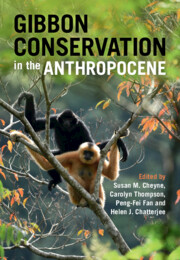Book contents
- Gibbon Conservation in the Anthropocene
- Gibbon Conservation in the Anthropocene
- Copyright page
- Contents
- Contributors
- Foreword
- Abbreviations
- Introduction
- 1 Taxonomy, Ecology and Conservation of Cao Vit Gibbon (Nomascus nasutus) since Its Rediscovery
- 2 Conservation Status of the Northern Yellow-Cheeked Crested Gibbon (Nomascus annamensis) in Vietnam
- 3 Strategies for Recovery of the Hainan Gibbon (Nomascus hainanus)
- 4 Gibbons in the Anthropocene
- 5 Demography of a Stable Gibbon Population in High-Elevation Forest on Java
- 6 A Tale of Two Gibbon Studies in Thailand
- 7 Accessibility as a Factor for Selecting Conservation Actions for Pileated Gibbons (Hylobates pileatus)
- 8 Calling from the Wild
- 9 Demography and Group Dynamics of Western Hoolock Gibbons (Hoolock hoolock) in a Community Conserved Village Population in Upper Assam, India
- 10 Challenges and Prospects in the Conservation of Hoolock Gibbon in India
- 11 Gibbons of Assam
- 12 Movement Ecology of Siamang in a Degraded Dipterocarp Forest
- 13 Sympatric Gibbons in Historically Logged Forest in North Sumatra, Indonesia
- 14 Adopting an Interdisciplinary Biosocial Approach to Determine the Conservation Implications of the Human–Gibbon Interface
- 15 Listen to the People, Hear the Gibbons Sing
- 16 Long-Term Outcomes of Positive Cultural Value for Biodiversity
- 17 Gibbon Phylogenetics and Genomics
- 18 The Use of Microsatellites in the Management of Captive Gibbons
- Index
- References
17 - Gibbon Phylogenetics and Genomics
Published online by Cambridge University Press: 13 April 2023
- Gibbon Conservation in the Anthropocene
- Gibbon Conservation in the Anthropocene
- Copyright page
- Contents
- Contributors
- Foreword
- Abbreviations
- Introduction
- 1 Taxonomy, Ecology and Conservation of Cao Vit Gibbon (Nomascus nasutus) since Its Rediscovery
- 2 Conservation Status of the Northern Yellow-Cheeked Crested Gibbon (Nomascus annamensis) in Vietnam
- 3 Strategies for Recovery of the Hainan Gibbon (Nomascus hainanus)
- 4 Gibbons in the Anthropocene
- 5 Demography of a Stable Gibbon Population in High-Elevation Forest on Java
- 6 A Tale of Two Gibbon Studies in Thailand
- 7 Accessibility as a Factor for Selecting Conservation Actions for Pileated Gibbons (Hylobates pileatus)
- 8 Calling from the Wild
- 9 Demography and Group Dynamics of Western Hoolock Gibbons (Hoolock hoolock) in a Community Conserved Village Population in Upper Assam, India
- 10 Challenges and Prospects in the Conservation of Hoolock Gibbon in India
- 11 Gibbons of Assam
- 12 Movement Ecology of Siamang in a Degraded Dipterocarp Forest
- 13 Sympatric Gibbons in Historically Logged Forest in North Sumatra, Indonesia
- 14 Adopting an Interdisciplinary Biosocial Approach to Determine the Conservation Implications of the Human–Gibbon Interface
- 15 Listen to the People, Hear the Gibbons Sing
- 16 Long-Term Outcomes of Positive Cultural Value for Biodiversity
- 17 Gibbon Phylogenetics and Genomics
- 18 The Use of Microsatellites in the Management of Captive Gibbons
- Index
- References
Summary
The gibbons (family Hylobatidae) occupy a key node in the primate phylogenetic tree. They are characterised by an accelerated rate of evolutionary chromosomal rearrangements. To date, despite much effort, the phylogeny of gibbons remains largely unresolved at the genus level, likely due to rapid divergence of the four genera approximately 5 million years ago. In this chapter we discuss various approaches used to untangle the complex phylogeny of the gibbons. We highlight the unique branching pattern of the gibbon tree, which suggests that the four genera diverged over short evolutionary time. Furthermore, we review how cutting-edge DNA sequencing technologies have improved our understanding of the evolution of the gibbon genome and how this can guide conservation efforts. In particular, we describe the mechanisms that have contributed to the highly rearranged karyotypes of the gibbon genera and how the birth and consequent propagation of the gibbon-specific transposable element LAVA might have shaped the evolution of this lineage by inserting within nearby genes involved in chromosome segregation and DNA repair. As more genetic resources and data are generated from gibbon species, we will gain further insight into the evolutionary history and enable progress towards generating greater infrastructures to conserve these threatened species.
- Type
- Chapter
- Information
- Gibbon Conservation in the Anthropocene , pp. 286 - 301Publisher: Cambridge University PressPrint publication year: 2023
References
- 2
- Cited by

